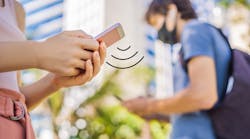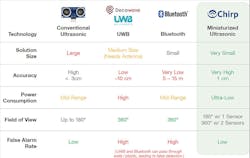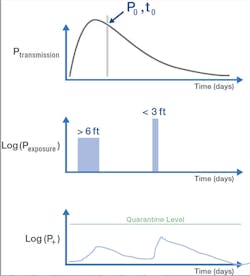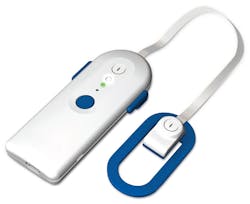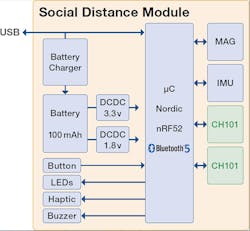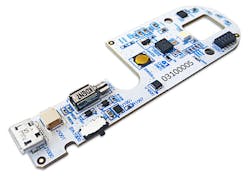Ultrasonic Range Sensors Bring Precision to Social-Distance Monitoring and Contact Tracing
As the world struggles with the impact of COVID-19, businesses and governments are seeking ways to safely restart global commerce and local economies to mitigate the financial impact of the virus. This will involve many people returning to their workplaces. However, with ongoing COVID-19 outbreaks and the threat of a second wave still present, the need to continue observing social distancing and contact tracing will be an important element in any plan for the safe reopening of businesses and operational facilities.
In many offices, factories, and other workplaces, where people need to be mobile to carry out their work activities, maintaining a safe physical distance becomes a dynamic issue because the proximity between workers is constantly changing. Some workers will move faster than others, and natural traffic bottlenecks will occur within workplaces that lead to closer levels of physical proximity than others. Even the time of day will become more relevant in the context of maintaining recommended distances between co-workers and visitors and tracking those contacts that do happen.
For most business leaders, these considerations are almost entirely new. While buildings are designed to support a steady flow of people, few architects could have envisioned the need for such a low density of traffic in communal areas, entrances and exits, corridors, or other open spaces. The building, however smart it may be, is unlikely to provide the necessary technology to support social distancing. It falls to new solutions to provide the answer.
The phrase “new normal” is now used to describe the precautions that society needs to consider to limit or prevent the threat of communicable diseases like COVID-19. Many scientists believe the outbreak of another virus is inevitable at some point in the future; nobody can say with any certainty how severe or prevalent it may be. The new normal, therefore, is to have precautionary measures ready for deployment. For viruses that attack the respiratory system, such as COVID-19, maintaining a physical distance is an effective way of preventing its spread, and contact tracing is an effective way of containing the spread after identifying an outbreak.
Range-Finding for Social Distancing
Social distancing is a relatively non-invasive measure that seeks to prevent transmission of the airborne virus by maintaining a set distance between and among people. While using guesswork to maintain social distancing is possible in informal situations, employing technology to implement strict social distancing is the preferred method in a busy workplace. It provides an automated “always-on” system that protects all workers while remaining as unobtrusive as possible to the user.
Ideally, these systems should also track and log data regarding which individuals have come in contact with each other (Fig. 1). This data is useful when an outbreak occurs to inform people that they have been in close proximity to a person who has subsequently been diagnosed positive for COVID-19 or other infectious disease. For a contact-tracing system to be effective, there needs to be some way of capturing and sharing data about the people being monitored, without infringing their privacy.
These enhanced social-distancing techniques almost exclusively use wireless technology to implement some form of peer-to-peer range-finding for proximity detection, along with a communications backhaul for sharing information securely. Of the many possible approaches, three are receiving the most interest: ultra-wideband (UWB), ultrasound, and Bluetooth technologies (Fig. 2).
Because of its ubiquity, specifically in mobile phones, many developers have been exploring how Bluetooth can be used to provide both proximity detection, based on receive signal strength indication (RSSI), and secure data transmission. Trials have been conducted to develop an application that uses Bluetooth's inherent features, such as broadcasting its identity in order to initiate pairing with other mobile phones in its area. Notably, Apple and Google have collaborated to produce an exposure notification system based on Bluetooth.1
While this type of system has the advantage of utilizing hardware that most people already own, the range accuracy that Bluetooth can deliver is on the order of two meters. In other words, the range of potential errors in distance measurement using Bluetooth is greater than the recommended social-distancing range, disqualifying it from being a safe option for wireless-based social-distancing applications.
In terms of accuracy, UWB performs much better than Bluetooth, delivering a proximity measurement accuracy of around 10 cm. However, another weakness that’s apparent with both Bluetooth and UWB—which, under other circumstances, might be a strength—is that their signals can pass through objects such as doors and walls. Ordinarily, users would want their wireless communications to travel as far as possible, through obstacles such as buildings, but when it’s being used for social contact tracing, this leads to false triggers.
For example, two people may be sitting in adjacent rooms, separated by a wall but less than two meters away from each other. Both Bluetooth and UWB would detect this as a proximity infringement. The poor range accuracy of Bluetooth means that users on separate floors of a building may record false contacts as well.
A third wireless technology option is ultrasound. Using the time-of-flight (ToF) principle, ultrasonic sensors can deliver accuracy in the region of a few millimeters, which far exceeds the accuracy achieved using any other form of wireless technology. ToF is a simple technique based on the time it takes for an ultrasonic pulse to travel from one person to another person. Using this principle with a known speed of sound allows the time of flight to be converted into an accurate measure of distance.
Because an ultrasonic wave is carried by air, unlike an electromagnetic wave, ultrasound can only travel between two people if there’s an unobstructed air path between them. This means ultrasound doesn’t return false positives if people are separated by a door, wall, window, or ceiling (Fig. 3).
Conventional ultrasound transducers are typically 1 cm3, much larger volume than the integrated circuits and antennas used to implement Bluetooth or UWB, for example. While size isn't an issue in applications such as parking sensors on cars, this could preclude ultrasound’s use in many other applications, such as smart tags worn by workers to provide proximity detection. However, the relatively recent development of MEMS-based ultrasonic transceivers means they’re now small enough (0.02 cm3) to be used in wearable technologies, such as social-distance monitoring tags.
Another key requirement in a social-distance tag is power consumption and battery life. Here, the fact that ultrasonic transceivers are orders of magnitude lower power than UWB and other RF technologies enables ultrasonic tags to have much smaller batteries and a longer time between charges.
Design Considerations for a Smart Proximity Tag
As outlined above, a proximity tag needs to do more than just detect the proximity of an object. It also must be able to establish a communications channel with other tags, quickly and with a low protocol overhead, in order to exchange other important information. Furthermore, it needs to be capable of managing multiple channels at the same time, as there’s no guarantee that only two people will be in close proximity at any one time.
On its own, an ultrasonic transducer would not be able to deliver this level of functionality, but one of the major benefits of MEMS technology is its ability to be integrated with conventional CMOS technology. The CH101 and CH201 ultrasonic MEMS transceivers produced by TDK Chirp Microsystems integrate MEMS transducers and a low-power mixed-signal integrated circuit in one package that measures 3.5 mm on each side.
The integrated circuit inside the transceiver package has an on-chip microprocessor that facilitates the ultrasonic measurement and allows for precise control over the timing of transmissions and receiving phases. In this application, precise timing is required, as the tag is only interested in receiving signals from other tags in its field of view (FOV), and it must not be subject to false-positive proximity events created by echoes from the user’s environment.
The way this is achieved in practice is to separate the transmitting and receiving phases in time. When the tag is using the ultrasonic transceiver to search for a nearby tag, it will first transmit, wait for any echoes from the environment to subside, and then listen for a reply from a nearby tag. If no reply is found, the tag will then listen for other tags during a random interval of time before repeating the process. Once another tag is detected, the tags can establish a secure connection using another form of RF communication, such as Bluetooth, to exchange data about each other.
The basic information, known as a contact record, consists of the ID of each tag encountered, the distance, and a timestamp indicating the time and duration of contact. For privacy reasons, no personally identifiable information (PII) or personal health information (PHI) need be stored on the tag, and the tag never has to record the wearer’s location data. By comparing a tag’s contact records against a database of infected IDs at regular intervals, the tag’s wearer—and in a workplace setting, the wearer’s manager—can be notified of possible exposure.
For example, an algorithm for estimating a user’s exposure is detailed in Figure 4. In the top plot, an infected individual’s onset of symptoms at t0 can be used to estimate the period when they were contagious and assign a base probability of transmission. In the center, a second user’s tag who had exposure to the tag of the infected individual had a long-duration exposure at a relatively long distance and a shorter duration exposure at very close distance. On the bottom, a probability of the second user falling ill (P+) is estimated based on the known contact windows. If the P+ becomes high enough, the second user’s tag should notify the user and the central authority that the user has a high risk of contracting COVID-19.
A tag could include other technologies to enable even smarter functionality, such as MEMS-based motion sensors to enable it to detect when a tag is moving and therefore begin sensing its surroundings. This would allow the tag to remain in power-saving mode when not in use, thereby extending the battery life.
When the tag is active, fusion of the six-axis MEMS motion sensor with a three-axis magnetometer will allow the tag to calculate its heading, and thus determine the relative angle between users. This enables the contact record to include information about whether the contact was face-to-face (which increases the probability of transmission). It may also be useful to include USB communications and onboard data storage so that the tag only delivers its information when docked to a PC or connected to a wireless access point.
Ultrasonic transceivers can have a very wide field of view, up to 180 degrees. However, airborne ultrasound is blocked by the wearer’s body. Consequently, a single sensor will only cover a hemispherical region in front of the wearer if the tag is worn as a badge or a lanyard. To achieve full 360-degree coverage, a second transceiver is required to cover the area behind the user (Fig. 5). The sensors on offer today support this extensibility, often by providing a two-wire interface such as I2C, along with a driver to allow a host microcontroller to manage a system with two, three, four, or even more transceivers.
This functionality would, for example, support a design where the transceivers are mounted on the rim of a hardhat worn on a construction site. They could equally be added to ear defenders in a warehouse or production environment. In an office, the transceivers could easily be integrated into a badge, bracelet, or even a face mask. Modern solutions consume extremely low levels of power, allowing a proximity tag to run for an entire week from a single coin-cell battery or small rechargeable lithium battery.
Chirp Microsystems also offers a development kit based on its CH101 ultrasonic MEMS sensor, which is part of the SmartSonic platform and based around a Microchip microcontroller (Fig. 6). The kit is supplied with a software development kit and GUI-based development tools, which can also be used to capture and analyze the data generated by the kit's sensors.
Conclusion
To reduce the spread of COVID-19 and the associated disruption, companies will need to enforce workplace social distancing where possible and enable automated contact tracing in situations where social distancing is impossible. The small size and low power consumption of modern sensors and integrated radios mean it’s now possible to make sophisticated solutions that combine range-finding with data logging, network interfacing, and onboard analysis to support the kind of automated contact tracing features now necessary for safer workplace interactions.
David Horsley is CTO and Richard J. Przybyla is System Architect at Chirp Microsystems Inc., a TDK Group company.
Reference
1. Apple and Google partner on COVID-19 contact tracing technology.
